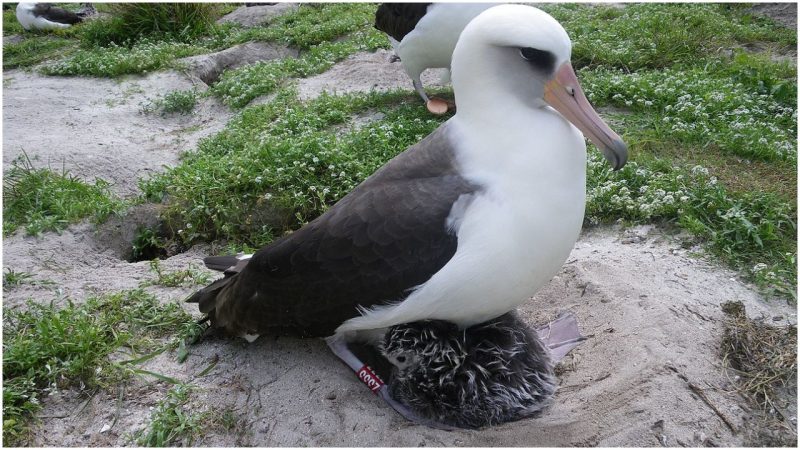It could be a graceful sight to watch a Laysan Albatross as it glides above the waters of the ocean. These beautiful birds that inhabit areas of the Pacific are famed for being relentless travelers, and while they commonly migrate to tropical islands or atolls across the Pacific Ocean to breed, they could reach Japan or California on their migratory routes. There is one member of this species, however, that has received much international attention. Her name is Wisdom, and she became famous as the world’s oldest known wild bird, and still breeding in the wilderness.
Like thousands of other seabirds, Wisdom returns each year to Midway Atoll in the North Pacific, roughly halfway between North America and Asia, and the news of her annual return was even more celebrated with the announcement that she had managed to lay a new egg, despite her age, which is now 67.
For many years now, Wisdom has been migrating back to the Papahānaumokuākea Marine National Monument with her current mate, named Akeakamai. The United States Fish and Wildlife Service (USFWS) reports that the pair mated in the latter part of November last year, and Wisdom delivered the new egg on December 13, 2017.
Experts believe that Wisdom has so far raised around 35 chicks throughout her almost seven-decades-long life, and has outlived several other mates before Akeakamai. This is of great interest to scientists, not only because Wisdom hatched an egg at such an age but also for an albatross to raise young in consecutive years (she did lay an egg in 2016 and 2017 too) is uncommon.
“It’s just unprecedented that we have a bird that we know of that’s 67 years old and still reproducing,” commented Kate Toniolo from the Papahānaumokuākea Marine National Monument. Toniolo adds: “It makes you wonder—could there be a bird two nests away from Wisdom that’s even older?”
Given the age of the albatross, it means it has managed to traverse up to three million miles since the mid-1950s, which would equal perhaps the distance of six trips back and forth between Earth and the Moon, the calculations being done from the U.S. Geological Survey.
Bob Peyton from USFWS also remarked on the overall importance of the albatross population: “If you consider that albatross don’t always lay an egg each year and when they do they only raise one chick at a time–each egg is tremendously important in maintaining the survival of a colony.”
The story of Wisdom goes back to 1956, when she was tagged on the Midway Atoll National Wildlife Refuge by Chandler Robbins, a biologist from USFWS. For decades afterward, the bird was not spotted, until 2002, when Robbins, the same person to band the bird, happened to re-encounter her again. The age of the bird and her still-solid fitness are reportedly the main reasons why Wisdom was chosen to be her name.
Just like the bird, Robbins remained busy and occasionally working long after retirement, passing away recently, in 2017, aged 98. Robbins had a great likeness for Wisdom, as he shared in an interview for National Geographic back in 2013. This bird has managed to evade the numerous threats her species face in a lifetime: deep-sea fishing activities, excessive plastic and other marine debris in the oceans, and predators who would like her for dinner. Robbins remarked that evading all such dangers and still raising young chicks “is quite extraordinary.” He further complimented these birds as having “a tremendous amount of knowledge in their little skulls.”
Related story from us: Lucy’s baby: The world’s oldest known child, and one who climbed trees
The Midway Atoll makes itself a home of thousands of albatross nests, and is one of the largest albatross colonies in the world. It is also inhabited by a few dozen other bird species which share the safety of this wildlife preserve. And across the vastness of the ocean, which year by year appears to be more and more polluted, remote areas such as this one have proven to be an essential haven for seabirds.
